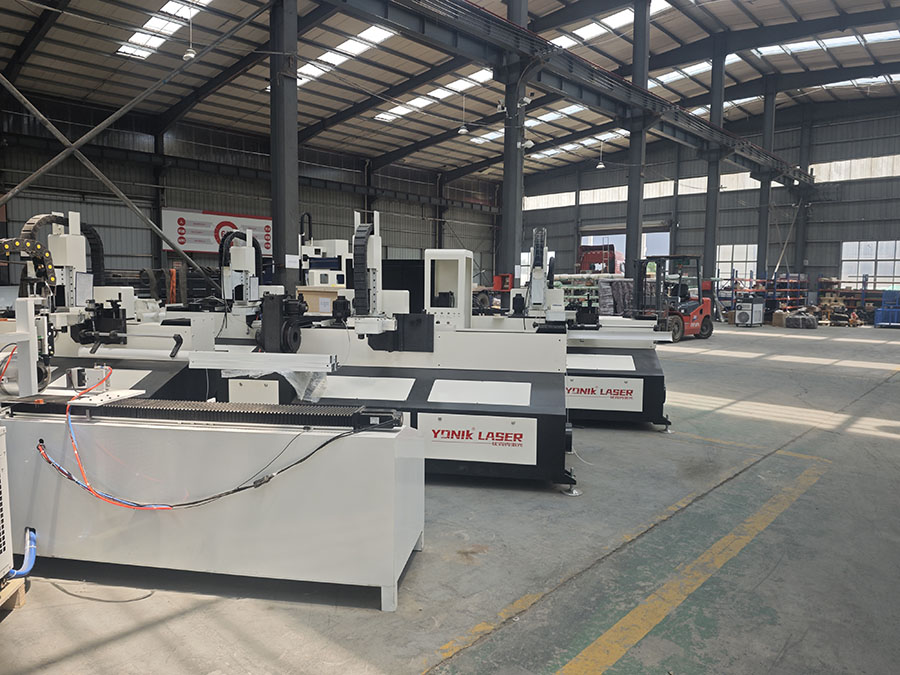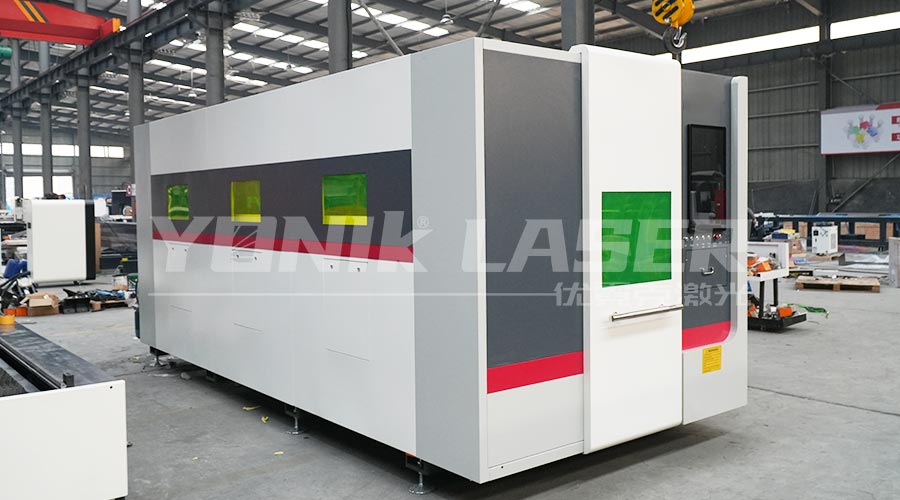As the manufacturing industry accelerates its transformation towards intelligence and precision, laser cutting machines have become core equipment in fields such as metal processing, aerospace, and automotive manufacturing, thanks to their advantages of high precision, high efficiency, and low energy consumption. However, even with increasingly mature technology, enterprises still face efficiency bottlenecks in actual production, such as insufficient cutting speed, excessive idle travel time, and poor material adaptability. This article will systematically analyze the key paths for improving the efficiency of laser cutting machines from three dimensions—process parameter optimization, equipment upgrade strategies, and intelligent system applications—to help enterprises achieve significant increases in production capacity and cost optimization.

1. Process Parameter Optimization: The "Golden Combination" for Precise Matching of Materials and Scenarios
The efficiency and quality of laser cutting are highly dependent on the synergy of parameters such as cutting speed, power, and gas pressure. For example, when cutting a 1.5mm-thick stainless steel car door in the automotive industry, setting the power to 1500W, cutting speed to 8m/min, and nitrogen pressure to 0.8MPa can achieve burr-free cutting. In contrast, when cutting a 3mm carbon steel exhaust pipe, the power needs to be increased to 2000W, the speed reduced to 5m/min, and the oxygen pressure adjusted to 1.2MPa to ensure penetration and a flat cutting surface. Achieving such precise matching of "material-thickness-parameters" requires the following steps:
Layered Parameter Debugging: For composite materials (e.g., galvanized sheet + aluminum sheet), parameters must be set in layers. For instance, when cutting, use low power for the galvanzed layer first and then switch to high power for the aluminum substrate to avoid deformation caused by differences in heat conduction.
Dynamic Focus Adjustment: When cutting thick plates, adopt a "segmented focusing" technique. For example, when cutting 10mm carbon steel, adjust the focus to 0.5mm below the material surface during piercing to enhance energy density, and then move it to 1.5mm below the surface during cutting to expand the molten pool and reduce repeated cutting.
Gas Synergy Optimization: When cutting carbon steel with oxygen, use a "pulsed gas supply" technique. During piercing, high-pressure oxygen is used to quickly blow away molten slag, while low-pressure oxygen is switched to during cutting to maintain a stable molten pool, improving cutting speed by 15%-20%.
An automotive component manufacturer achieved a 28% increase in the overall efficiency of its laser cutting machines through the above methods, raising single-shift production capacity from 1,200 pieces to 1,540 pieces while reducing the rework rate from 3.2% to 0.8%.
2. Equipment Upgrade Strategies: Full-Link Optimization from Hardware to Systems
Equipment performance is the physical foundation for efficiency improvement. The coordinated upgrade of high-power lasers, intelligent control systems, and automated auxiliary equipment can build a solid "hardware support" for efficient cutting:
High-Power Laser Selection: For example, a 30kW fiber laser can cut 20mm carbon steel at a speed of 1.2m/min, three times that of a 10kW laser. It can also cut 10mm stainless steel at 4.5m/min, improving efficiency by 40%. Enterprises need to select power based on material thickness distribution to avoid resource waste from "over-sizing" or "under-sizing."
Optical Path System Upgrade: By adopting dynamic focusing technology and using variable-curvature mirrors to adjust the beam diameter in real time, the focal position error can be controlled within ±0.02mm, significantly improving cutting precision and speed. A sheet metal processing enterprise introduced this technology and increased the straight-line cutting speed of 0.8mm aluminum alloy from 18m/min to 22m/min, reducing edge roughness to Ra1.6μm.
Integration of Automated Auxiliary Equipment: Equipping automatic loading/unloading systems and intelligent sorting devices can reduce manual intervention time. In the agricultural machinery industry, for example, integrating robotic arms with visual positioning systems enables fully automated processes from sheet loading to finished product unloading, increasing daily production capacity per machine from 800 pieces to 1,200 pieces and reducing labor costs by 60%.
3. Intelligent System Applications: Transformation from Experience-Driven to Data-Driven
The deep integration of intelligent algorithms and industrial software is reshaping the production logic of laser cutting. Through functions such as path optimization, parameter prediction, and fault warning, enterprises can break through the efficiency limits of traditional production modes:
AI Path Planning Algorithm: A deep learning-based path optimization system can automatically analyze workpiece contour features and generate the shortest cutting path. For example, when cutting 100 circular workpieces, traditional methods require 1,200mm of idle travel, while an AI algorithm can reduce it to 850mm, improving efficiency by 29%. An advertising production enterprise increased its daily processing capacity from 600 square meters to 780 square meters and improved equipment utilization by 30% after applying this technology.
Digital Twin Parameter Prediction: By constructing a digital model of "material-parameter-quality," the system can recommend optimal parameters in real time. For example, when cutting 3mm stainless steel for kitchenware, after inputting parameters such as material thickness and hardness, the system automatically generates a solution with a power of 1800W, speed of 6.5m/min, and nitrogen pressure of 1.0MPa, stabilizing the cutting surface roughness at Ra0.8μm or below and improving the pass rate to 99.2%.
Remote Operation and Fault Warning: Laser cutting machines equipped with IoT sensors can monitor key indicators such as laser temperature and water cooling system pressure in real time. When data deviates from thresholds, the system automatically sends warning messages to maintenance terminals. An automotive mold enterprise reduced equipment downtime from 12 hours per month to 3 hours using this function, saving over 500,000 yuan in annual maintenance costs.
4. Industry Practices: Implementation Cases of Efficiency Optimization in Different Scenarios
Aerospace Field: When cutting titanium alloy thin sheets, the "ultra-pulse + low-frequency modulation" technique reduces the heat-affected zone width from 0.3mm to 0.15mm while increasing the cutting speed to 8m/min, meeting the dual requirements of lightweight and high strength for spacecraft.
Apparel Manufacturing Industry: Visual positioning laser cutting machines can recognize fabric elasticity and texture in real time and automatically adjust cutting paths and power. An high-end apparel enterprise increased its daily cutting capacity from 3,000 pieces to 4,500 pieces and improved fabric utilization by 8% after applying this technology.
Fitness Equipment Industry: For tube cutting needs, introducing laser tube cutting machines with swing axes enables precise cutting of bevel angles from 0° to 45°. A fitness equipment enterprise reduced the time for tube splicing and welding from 12 minutes per piece to 7 minutes per piece, increasing production capacity by 71%.

Conclusion: The Future Landscape of the Efficiency Revolution
Optimizing the efficiency of laser cutting machines represents a comprehensive upgrade from processes to equipment and from hardware to software. With the popularization of ultra-high-speed lasers above 30kW, AI-driven intelligent control systems, and fully automated production lines, laser cutting is evolving from "point breakthroughs" to "systemic revolutions." Enterprises must use data as a link to build a collaborative innovation ecosystem of "processes-equipment-management" to seize opportunities in the wave of intelligent manufacturing and achieve a leap from "scale expansion" to "value creation."
2025-07-22
2025-07-21
2025-07-19